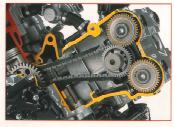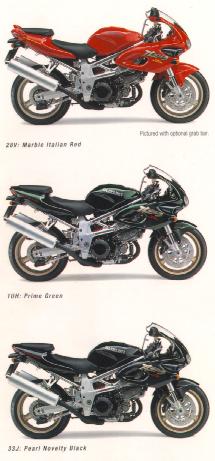Suzuki Press Kit : Page 3
Integrated Engine and Chassis Design.
 Redefining state-of-the-art V-Twin technology took more than building a new engine and leaving the rest to the chassis men. The Suzuki engineering department assembled an experienced team of engine, chassis, suspension and electronics specialists to work together on the integrated design of the TL1000S.
Redefining state-of-the-art V-Twin technology took more than building a new engine and leaving the rest to the chassis men. The Suzuki engineering department assembled an experienced team of engine, chassis, suspension and electronics specialists to work together on the integrated design of the TL1000S.Fist came design goals, defined in terms of relative performance like lightest and best-handling. Postitioning the cylinders closer to a classic, upright V allowed ideal swingarm length with shorter wheelbase and a steeper head angle, but moved the rear cylinder head an exaust header pipe into the space needed for a conventional shock absorber. So the engineers created a new type of rear suspension with a unique rotory damper.
Clever valve train design reduced cylinder head and overall engine height. A chain runs fron an intermediate shaft gear-driven by the crankshaft to an idler shaft carrying a small-diameter drive gear cintered undereneath each set of dual overhead cams. And each cylinder head's exhaust cam is postitioned 10mm lower thain its intake cam, measured from the head gasket surface.
Staggered placement of the transmission shafts made the engine shorter front-to-rear, and an exceptionally short crankshaft made the engine narrower. Reducing both those dimensions concentrated more of the engine mass close to the center of gravity, which in turn could be lowered without compromising cornering clearance.
A built-in back-touque limiter allowed the clutch to be smaller and lighter. The system smooths dounshifts by reducing pressure on the plates under deceleration, and acts as a power-assist system by increasing pressure on the plates under acceleration.
Two-stage electronic fuel injectio and digital engine management sy stem eliminated driveability problems traditionally encountered with big V-Twin engines turning at very low rpm. Straight-port downdraftcylinder heads with ram-air induction increased high-rpm power.
And a new type of space frame combined aluminum alloy extrusions, forgings and castings to form the centerpiece of a lightweight chassis with exceptional torsional regidity.
Traditional Displacement, Modern Classic Execution
The TL1000S'
displacement is a traditional favorite, the execution a torque-producting modern classic made shorter, narrower and more compact by careful attention to the details. The basic layout includes two cylinders positioned 90-degrees apart, downdraft cylinder heads with four valves per cylinder, double overhead cams and liquid cooling. A big bore, short stroke, 98mm x 66mm layout produces 996cc and an efficient, high-revving bore/stroke ratio of 0.673:1. The big bore makes room for big valves, 40mm intakes and 33mm exhausts with 5.5mm stems, and the short stroke reduces cylinder height. The connecting rods ride side-by-side on a single crank jounal, and the short, rigid crankshaft itself rides in two plain main bearings.Downdraft, straight-port cylinder heads with compact combustion chambers produce an 11.3:1 compression ratio. The valves are steeply inclined with an included angle of 29 degrees, the intake valves 14 degrees from vertical and teh exhaust valves 15 degrees from vertical.
 The valves are opened by cam lobes acting directly on bucket tappets, and valve lash is adjusted with replaceable shims located underneath the buckets. But while that's established high-performance practice, the innovative cam drive system is all new. Basic four-stroke design requires that camshafts spin at half crankshaft speed. Most cam drive systems use a chain and sprockets, with cam sprockets twice the size of the crank sprocket. Because the crank sprocket cannot be any smaller than the crank jounal diamiter, which is calculated to suit engine displacement and loading, camshaft sprocket size is pre-determined. In the case of an engine using relatively large-diamerter crank journals, significant cylinder height is added by the double-size cam sprockets.
The valves are opened by cam lobes acting directly on bucket tappets, and valve lash is adjusted with replaceable shims located underneath the buckets. But while that's established high-performance practice, the innovative cam drive system is all new. Basic four-stroke design requires that camshafts spin at half crankshaft speed. Most cam drive systems use a chain and sprockets, with cam sprockets twice the size of the crank sprocket. Because the crank sprocket cannot be any smaller than the crank jounal diamiter, which is calculated to suit engine displacement and loading, camshaft sprocket size is pre-determined. In the case of an engine using relatively large-diamerter crank journals, significant cylinder height is added by the double-size cam sprockets.An alternative is to drive the cams with a series of stacked gears, but that approach adds significant weight and complexity. So Suzuki engineers combined the best of both systems. The cams are gear driven from underneath by a centered idler shaft. A chain runs between each idler shaft and an intermediate shaft, which is gear driven off the right side of the crankshaft, producing the necessary speed reduction. Because the idler shafft turns at half crank speed, the cam drive gear and the cam gears can be the same size and run 1:1, with a much smaller diameter than a conventional cam sprocket. Because the cam gears are smaller, overall cylinder height can be reduced. Simplified routing also means that the automatic tensioner system needs less force to eontrol the cam chain, reducing frictional losses. Cam removal is simplified without a cam chain routed over camshaft sprockets. And vertically-split, spring-loaded cam drive gears eliminate backlash to reduce mechanical noise.
Aluminum cylinders are plated with Suzuki's own race-proven nickle-silicon-carbide coating, called SCEM (Suzuki Composite Electrochemical Material). SCEM cylinders are lighter and more ddurable than conventional cylinders with cast-iron liners, transfer heat better and closely match the expansion rate of pistons, allowing for closer piston-to-cylinder clearance.
Cast aluminum alloy pistons feature short skirts and cutaway sides with a short wrist pin to reduce weight. An L-shaped upper compressin ring is puched downward in the ring groove by combustion gasses, improving ring seal and avoiding excessive blowby that could be encountered in a high-revving, large-bore engine design using conventional rings. The L-shaped ring is also lighter and more resistant to flutter at high rpm. A jet at the base of each cylinder directs a stream of oil onto the underside of the piston dome, reducing piston tempature.
Innovative design also made the engine more compact front-to-rear. The crankshaft and two transmission shafts are not lined up along the same horizontal plane. Instead, the shafts are staggered in the vertically split crankcases, the transmission input shaft positioned slightly below the crankshaft centerline and the transmission output shaft positioned slightly above the crankshaft centerline. Staggering the shafts vertically allows them to be positioned closer together, reducing overall engine lenghth.
 The movement of two large-displacement pistons through their cycles causes significant variations in internal crankcase pressure. Conventional V-Twin engines vent crankcase pressure through a large-volume, maze-type oil separator, which vents pressure to the airbox and returns separated oil to the crankcases through a small passageway. The TL1000S has a patented new type of small-volume, compact crankcase breather and oil separator. A one-way reed valve in the floor of the breather is controlled by changes in crankcase pressure. When internal crankcase pressure drops, the reed valve opens and separated oil quickly returns to the cases through a relatively large port.
The movement of two large-displacement pistons through their cycles causes significant variations in internal crankcase pressure. Conventional V-Twin engines vent crankcase pressure through a large-volume, maze-type oil separator, which vents pressure to the airbox and returns separated oil to the crankcases through a small passageway. The TL1000S has a patented new type of small-volume, compact crankcase breather and oil separator. A one-way reed valve in the floor of the breather is controlled by changes in crankcase pressure. When internal crankcase pressure drops, the reed valve opens and separated oil quickly returns to the cases through a relatively large port.An oil cooler is mounted below the forward cylinder, above a case-mounted spin-on oil filter. The aluminum radiator is positioned above and in front of the forward cylinder, between the sides of the half fairing. Internal coolant passageways between the cylinders reduce the number of external hoses.
Ramped engagement cams built into the clutch hub increase pressure on the clutch plates under acceleration, and decrease pressure on the clutch plates under deceleration. The system makes it possible to handle the TL1000S' formidable power with smaller-diameter plates in a more compact clutch assembly, with lighter clutch springs. Because pressure on the plates decreases under deceleration, the system acts as a back-torque limiter and contributes to smoother downshifts. The two-piece primary drive gear is spring-loaded to help reduce mechanical noise caused by backlash. An outer cover with a reuseable O-ring seal allows clutch access without disturbing the water pump.
An AC generator located on the left end of the crankshaft is oil cooled, allowing its output to be increased by 10 percent. To reduce weight, the generator cover and the cam covers are magnesium, while the outer clutch cover is high-impact, sound-absorbing plastic.
An automatic decompression system makes it easier to turn over the engine, allowing the starter motor and battery to be smaller and lighter. The centrifugally-controlled system releases compression by holding an exaust valve slightly off its seat at initial cranking speed, and deactivates when the engine fires.
A linked two-into-two exhaust system culminates in large-volume aluminum mufflers with stainless steel tips.